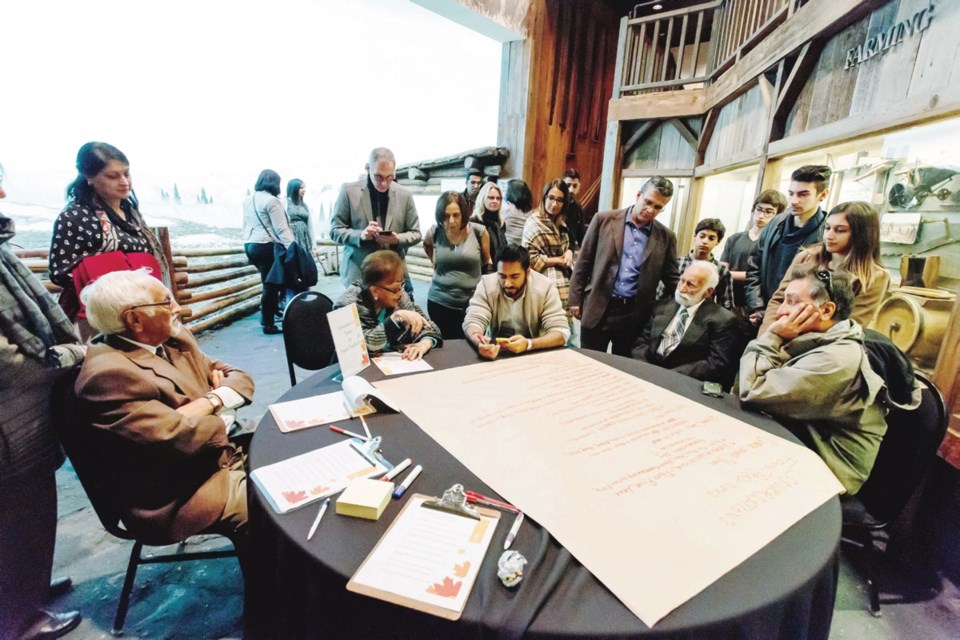This is one of a series of columns by specialists at the Royal B.C. Museum that explore the human and natural worlds of the province.
British Columbia is a culturally diverse place. The Centre of Arrivals project, the Royal B.C. Museum’s multicultural and intercultural initiative, takes account of this.
It’s a long-term project to explore, preserve and share this diversity through research in our collections and making connections with many different ethnic communities, collecting information and material objects.
A focus on immigrant history, with a special emphasis on the transnational context, broadens our understanding of the intercultural and historical complexities of our shared history, with special reference to the role of B.C. as a gateway between Asia Pacific and the Americas.
Work on the project is underway. With the financial support from the H.Y. Louie Family Co., and the assistance of many community partners, research centres, and the Ministry of International Trade, the Ministry of Education and Open School B.C. on projects such as the Chinese Canadian Legacy Initiatives, we have completed much work.
Educational tools such as travelling exhibitions, an online digital collection, on-site programming and an outreach box featuring learning materials have travelled around the province to support the B.C. social studies curriculum. Some of these tools have even travelled to other parts of Canada and China.
The current five-year plan builds on this foundation, with ongoing work with B.C.’s diverse communities in preparation for celebrating B.C. 150 in 2021. By that time, we hope to have completely refreshed our modern-history gallery.
For many years, the museum has collected artifacts significant to various multicultural groups in the province, but research for the Gold Rush exhibition revealed many gaps in the collection about British Columbians who were neither First Nations nor Anglo-Canadian.
As we began research for the 2017 exhibition Family: Bonds and Belonging, we made a special effort to begin filling these gaps — collecting artifacts and doing interviews, which provide us with intimate, detailed knowledge about communities.
As a result, the family exhibition included family letters written in Punjabi between the wife in the Punjab and husband in B.C. during their years of separation in 1930-47; letters in Chinese between a father in Hong Kong and son in Vancouver that later shaped the business ethics and practices for generations in the H.Y. Louie Co.; a series of diverse textiles; and artifacts from the francophone Guichon family.
We hope the new modern-history gallery will feature stories of immigrant families, highlighting B.C.’s global links and making its intercultural experience relevant and engaging for our visitors. One result will be an interactive map — in the gallery and online — that connects B.C. to different corners of the world through immigrant routes, historical chronologies and examples of relevant items from the museum’s collections.
The Punjabi Canadian Legacy Project
In partnership with the South Asian Studies Institute at the University of the Fraser Valley, we’ve completed the first (research) phase of the Punjabi Canadian Legacy Project, collecting 92 oral histories in 2014-15 and data from eight provincewide community consultations in 2015-6.
Previously under-represented Punjabi Canadian communities around the province identified what they would like to see preserved and shared as their collective heritage — and how. One example is the central significance of sawmills as an important link to early Punjabi Canadian history. We heard a story about an early Punjabi who couldn’t initially get work due to his turban; when he eventually found work at a sawmill, he once used his turban as a lasso to save someone who was drowning.
The second phase of our plan is dedicated to provincewide engagement and legacy-building. The Punjabi Canadian community recommended we continue our community engagement and provincial outreach by creating a travelling exhibition, oral history collections, digital platforms and diverse learning tools and publications.
The Royal B.C. Museum also worked in partnership with B.C.’s Heritage Branch, the University of the Fraser Valley and a separate evaluation team on the South Asian Canadian Historical Places Recognition Project, which officially recognized historic places significant to South Asian Canadian communities in B.C. in March 2017.
Feeding the Family II: Immigrants’ Transnational Food Practices in British Columbia
Food history is essential for collective memories. In 2016, the Royal B.C. Museum created a travelling exhibition to celebrate the 125th anniversary of Ukrainian communities coming to Canada. In this and other community history research, food — more than religion and cultural performances — binds the people in diaspora together.
This long-term research project traces diverse food traditions and ingenuity in B.C. as a result of immigrants’ movements, local farming and ranching experiences. With help from many museum staff and volunteers, we launched a curated online digital food packaging collection this year (royalbcmuseum.bc.ca/ about/explore/centre-arrivals/ food-history-project).
All the Centre of Arrivals initiatives I’ve mentioned envision a reinterpretation of British Columbia history with diverse stories that will make more visitors feel “culturally at home” and inform everyone about the many cultures that make up British Columbia.
So far, the Centre of Arrivals research has informed collections development, online and onsite educational programming, online feature collections, gallery-refresh planning, travelling and feature exhibitions, and provincial outreach, as well as academic and other publications.
These partnerships, the growth of our collections, and the advancement of public, academic and community understanding are the legacy our museum is building — the province’s collective heritage. The history of B.C. as a gateway and a centre of arrival is key to re-envision regional, national and global history.
Tzu-I Chung, PhD, is curator of history at the Royal B.C. Museum. She is a cultural and social historian, broadly interested in transnational migration within the context of historical, cultural and economic interactions between North America and Asia-Pacific and of cultural and economic globalization. Her recent publications deal with environmental cultural studies, comparative ethnic studies and transnationalism.



